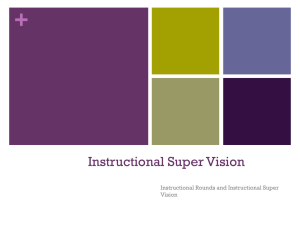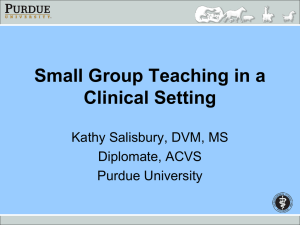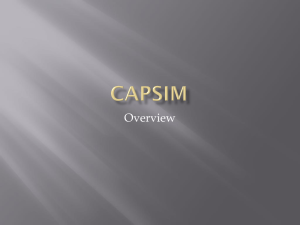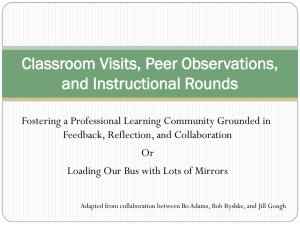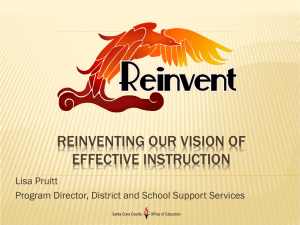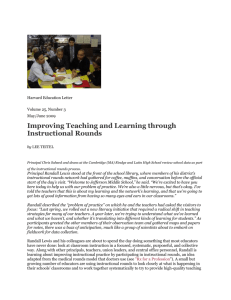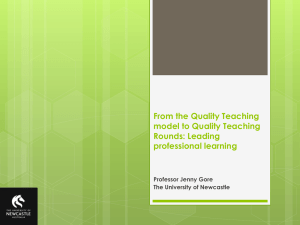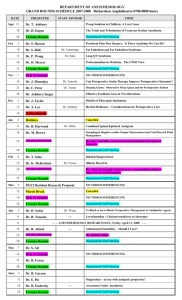Instructional Rounds - East Bay Charter Connect
advertisement
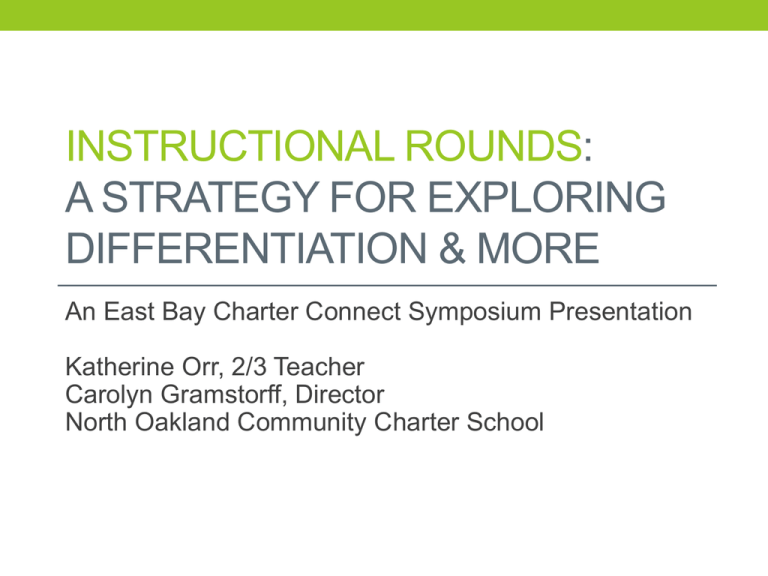
INSTRUCTIONAL ROUNDS: A STRATEGY FOR EXPLORING DIFFERENTIATION & MORE An East Bay Charter Connect Symposium Presentation Katherine Orr, 2/3 Teacher Carolyn Gramstorff, Director North Oakland Community Charter School Show me a school where the students are learning and I’ll show you a school where the teachers are learning. - Linda Darling Hammond (a rough quote ) Session Objectives • To share how and why we are using instructional rounds at NOCCS • To invite feedback and dialogue about instructional rounds and their use/potential for supporting staff and student learning Session Agenda • Pair-Share (5 – 10 Minutes) • Presentation (15 Minutes) • Clarifying Questions (5 – 10 Minutes) • Warm Feedback (5 – 10 Minutes) • Suggestions (5 – 10 Minutes) • Final Reflection (5 – 10 Minutes) WHAT ARE SOME WAYS YOU/YOUR STAFF HAVE EXPLORED BEST PRACTICES FOR DIFFERENTIATED INSTRUCTION? WHAT HAS WORKED? WHAT’S BEEN CHALLENGING? Pair - Share Why did we pilot instructional rounds? • To create an additional structure where teachers could learn from and share with one another. • Support the vertical alignment of curriculum and instructional practices. • To support staff in identifying and sharing best practices for differentiated instruction. Logistics • The staff is split into two vertical teams that consists of members from each grade level span. • Team A: Lily (K/1), Katherine (2/3), Kate (4/5), Natalie (6-8) • Team B: Mariah (K/1), Ember (2/3), Serian (4/5), Lee (6-8), Simon (6-8) • We conduct one “instructional round” per week – one team observed the other or a single grade level team each week. • While team members are out of their classroom, the Associate Teachers take over instruction. • Rounds last for one hour. • Instructional Rounds adhere to a protocol: • 5 -10 minutes: Prep and setting a focus for rounds • 40 minutes: Teams observe • 10 minutes: Debrief / Reflection • At/before the end of the day, team members log a journal entry about their observations, thinking, and ongoing learning related to differentiated instruction. • Approximately once per month the staff meet to reflect on/debrief their observations and learning. QUESTIONS WE’VE EXPLORED – FALL ROUNDS Each set of instructional rounds has a focus and set of questions that guide our observations Physical Space and Movement • How are NOCCS classrooms set up? What evidence of differentiation systems do you notice (furniture arrangements, folder, table groupings, agendas)? • How do students move about and access the room? Where did they go and what were they doing there? • How does the teacher move about the room? Where did s/he go and what did s/he do there? • Who does the teacher make contact with and in what configurations (whole group, small group, one on one, etc.)? Systems and Questions • What evidence of differentiation systems do you notice (folders, signage, agendas, table groupings, assignment/work packets)? How are these systems taught to and/or used by students? How are they used by teachers? • Who does the teacher make contact with and in what configurations (whole group, small group, one on one, etc.)? • What does the teacher ask or say to the students s/he is working with? What do the students ask or say to the teacher? What do the students ask or say to one another? Resources, Lesson Structure in Small Groups, Engagement • How are resources being allocated to support differentiation of instruction. In particular, what is the role of the two most important resources in the classroom – the teacher and the associate teacher? How are they deployed? What types of instructional tasks are they focused on? • One of the things we hope you will be able to do today is to sit and listen in on a small group (differentiated) lesson. Observe who the teacher is working with. What is the structure of their lesson? What types of instruction does the teacher or associate teacher enact? What types of questions does the teacher ask? How do the kids react? • Finally, we also hope that today will also afford you the opportunity to take a look at (and listen to) the students who are not working with the teacher or associate teacher. What are these students working on? What is their level of engagement? STAFF REFLECTIONS AND LEARNING What are we learning about differentiated instruction? • Room set up (reminders on wall, organization) • There are different ways to structure differentiated instruction (thinking outside my box) • Menus • Math rotations • Small group mini-lesson instruction • Challenges of small group instruction • Room use and size • Kid size • Volume of kids • Tracking versus Flexible Groups What questions have come up in terms of differentiation? • How to differentiate when teaching writing other than conferencing? • First writing assignment as assessment • Form instructional groups based on product and add extra mini- lessons with small groups • What to do for students who struggle to finish? • How do we form groups? • What are systems to track groups, classwork, and follow through? • How do we ensure enough time for independent practice before individual assessments? • What does good instruction look like in small groups (how do you get the most bang for your buck)? The NOCCS Differentiated Instruction Book If chapter 1 is titled: Setting the Groundwork and Foundation for Differentiated Instruction what would our sections cover? • Effective time management • What do you teach whole group vs. small group • • • Know the difference and be flexible If something is multi-step, it might need small group Knowing who needs 1:1 when • Spend lots of time training the students (who are not in the small/teacher group) to work independently • You don’t actually teach in the small group during the first month – its really about training the kids what to do • Routines and agenda must be posted – work must be organized • Room must be set up effectively for movement and traffic flow • Accountability for students • Take choice time or recess to finish? • Pick top 3 pieces of unfinished work (high priority) • Understand what equity means – know your students • Use parent survey/data to help you to understand your kids • Use small group time to watch how kids work • Use small group time to work one on one with students • Assess • Communication and patience • Give students tools to know themselves as learners • Have students tell you their experience – write you a letter • Observe their process and watch how they change unit to unit (often you see a student differently depending on the subject matter or topic) What should we focus on in Chapter 2? – Moving forward “wonders”: • How do we effectively use AT/TAs? • Rotation of small groups and time break down – looking at more of the whole lesson and transitions • Behind the scenes interviews with teachers • What are you choosing to modify? How? When? • How do you manage your time? Who is a “work smart” person that can help us? • What programs can help us? • Looking at equity students – follow and observe what s/he does during a lesson • When is a small group more effective than a whole group? Does age factor in to the small group model? What’s appropriate at different ages/grades? • What do you do for the small few that really get it or really didn’t get it? • How do we not get overwhelmed by the amount of materials necessary to differentiate effectively? What Are Teachers Learning? What’s the Impact? • It’s useful to see where students will advance to (higher grades) and what • • • • • • their experience is in other grade levels. I got concrete ideas for organizational structures. It is useful to see the systems in action (and see their impact) so that I can see them and then mimic/translate/adopt/adapt. Community building. It’s useful to see other age groups. It helps me to feel more connected to other students. I have thought more about my practice and structures. I am thinking more about vertical alignment. I’m reflecting on how we could be more aligned (K to 8) and how structures also need to be different in order to do this in a developmentally appropriate manner. I have done some concrete things as a result of seeing my colleagues in practice. For example, I have made a noise chart and implemented a new organizational binder system that a colleague uses. It is easier to adapt and use new systems when you can see them in practice rather than having someone explain it to you. It provides you with time and space to see each other (prior to this I had a heard a lot of great stuff, now we have time set aside to do this). HOW OUR ROUNDS ARE CHANGING BASED ON TEACHER FEEDBACK? Winter Rounds • Bringing Instructional Rounds into our overall educational priority of ELA/Writing • Assessment development Unit writing Unit Critical Friends/Refinement Instructional Rounds Looking at Student Work • Taking a “deep dive” into seeing one grade level team at a time • Making time for debriefing what we see with the teachers, asking each other questions/wonders that come up CLARIFYING QUESTIONS 5-10 minutes WARM FEEDBACK What’s exciting? What seems like it works and makes sense? 5 – 10 minutes SUGGESTIONS How could we think about our rounds differently? What ideas do you have that could make our rounds even better? How could you use this at your school? 5-10 Minutes PRESENTERS REFLECTION & APPRECIATIONS 5 – 10 Minutes
